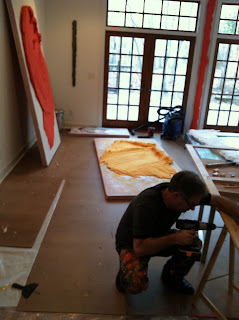Steve McCurry's colour-rich photographs on view at Museum für Kunst und Gewerbe
HAMBURG.- Museum für Kunst und Gewerbe in Hamburg is showing a comprehensive overview of the colour-rich oeuvre of photo journalist Steve McCurry. The American gained international acclaim in 1979 when he was one of the first to take photographs of the conflict in Afghanistan, which were subsequently published in Time Magazine, the New York Times and Geo magazine. In 1986, this multi-award-winning photographer joined the renowned Magnum Photo agency, which was founded in 1947 by photographic legends such as Robert Capa and Henri Cartier-Bresson. Steve McCurry claims he does not photograph war as such, but rather the “fringes of war”. He takes pictures in crisis areas, aiming his lens at scenes he observes on the fringes of the actual conflict, and at the people and landscapes war leaves in its wake. McCurry documents the wounds of war, disappearing cultures and their traditions, the consequences of globalisation and changes to the fabric of life. He sees himself as a traveller who contemplates the facets of human existence in his work. The exhibition comprises some 120 photographs taken between 1980 and 2012 in countries such as Afghanistan, the United States, Pakistan, India, Tibet, Kashmir, Cambodia, Indonesia, Burma and Kuwait. In addition, ten selected reportages from Geo, National Geographic, Stern and Need magazines are displayed, which demonstrate how the work of a photo journalist is applied.
Although McCurry plans his shots as a series, he succeeds in condensing scenes into individual images so skilfully that they tell entire stories. An example: He shows five women, completely covered by traditional burkas, in front of a market stall in Kabul. Above their heads hang pairs of modern trainers, a symbol of the assimilation of men’s and women’s clothing, of movement, of western mass production. Brought thus together in one picture, they clearly document the clashing of tradition and innovation.
McCurry uses colour as a powerful stylistic device in order to provoke the observer in his war images with the contrast between beauty and the horrors of war. An example of this is the portrait of the Afghan girl that appeared in National Geographic magazine in 1984. The photograph, one of the most widely published images of war, became a symbol of war and its consequences. The girl’s face is Madonna-like; only her sparkling, bright green eyes strike the observer, giving a sense of how much insecurity war has brought to the life of the then 12-year-old. With the combination of colours, McCurry draws the observer’s gaze into the image and emphasizes its symbolic power.
The shades McCurry uses in his work are not limited to countries like India, where colour plays a huge role. In his photographs of China and Bangkok he captures the bright robes of monks, and in Afghanistan oranges stand out in the midst of bleak, war-torn daily life, charging the situation with emotion. McCurry plays with the colour worlds of different cultures, which appear alien and fascinating to travellers as they break away from the sights one is used to seeing. In his photos McCurry skilfully condenses the intensity and forcefulness with which the foreign colours draw the observer in from outside.
In 1984 McCurry was asked to join the renowned Magnum Photo agency. The agency, which counts numerous war reporters among its members, sells images to magazines, publishing houses and museums. In contrast to other agencies, the photographers are not commissioned to produce certain works, but work independently and select their themes for themselves. McCurry’s works published in magazines such as Geo, National Geographic and Time Magazine are also the fruit of this tradition. As a photographer, McCurry aligns himself with Henri Cartier-Bresson, who claimed a photographer should be “always on the alert and ready to jump, decisively, to ‘capture’ life”. As a Magnum photographer, McCurry feels an obligation towards classic documentary photography and thus the truth, i.e., he sees himself as an eye-witness who produces images without manipulation. “If you want to call Walker Evans, Dorothea Lange, André Kertész and Henri Cartier-Bresson documentary photographers, then I’d be proud to be called one,” says McCurry.
Steve McCurry was born in a suburb of Philadelphia, Pennsylvania. He studied film and history at Pennsylvania State University in the Arts and Architecture faculty with the aim of becoming a documentary filmmaker. In 1972 he turned his attention to photography. Unlike film, this gave him the chance to be independent, to work without a team and a large budget. His desire to travel and to get to know other worlds and cultures led him to photography. Early on, he expressed his admiration for the works of photographers Brassai, Robert Capa and Diane Arbus. After completing his studies, he worked initially on the local newspaper “Today’s Post”. Having worked independently for some years, he travelled to India and Afghanistan for the first time in 1979. Disguised as a Mujahedeen fighter, he managed to enter into Afghanistan and supplied the first photos of the Afghanistan conflict to the western world, which were subsequently published in the New York Times, Time Magazine and Geo in 1980. McCurry has been awarded various prizes for his work, including the Robert Capa Gold Medal and the National Press Photographers Award.
To see the original article on ArtDaily click HERE.
To see the museum exhibition website click HERE.
GREENWICH 405 Greenwich Avenue•Greenwich, CT•06830• 203.869.3664
NEW YORK 15 East 71st Street, Suite 2a•New York, NY• 10021 • 212.570.4696
NANTUCKET 34 Main Street • Nantucket, MA•02554 • 508.325.4405











